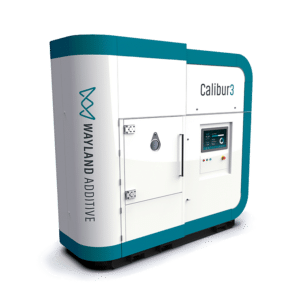
World-leading additive manufacturing (AM) technology, developed with support from Innovate UK through a NATEP project, is making an impact in industry just two years after the project concluded.
Huddersfield-based Wayland Additive is focused on making electron beam (eBeam) AM more effective and accessible to industry for a broader range of applications, and led the 18-month Ti64 Advanced Processes for Aerospace Structures (TAPAS) project with the University of Huddersfield as research partner and Boeing as end-user.
The project, which ended in 2021, helped “lay the groundwork for what we’re doing now”, said Ian Laidler, Wayland chief technical officer.
“TAPAS was all about how to use the power and speed of an eBeam for more efficient AM,” said Laidler.
The challenge was to manage the ‘melt pool’ or pools created by the power source, keeping them stable over a variety of geometries, controlling the heat loading more effectively to avoid swelling, heat spots etc.
“We proved it would work, got it working, and now it’s our default strategy,” said Laidler. Wayland calls it NeuBeam, for neutral beam electron beam melting (EBM), and it is at the heart of the company’s Calibur 3 system.
To date, four systems have been shipped. All are working in industries including aerospace, oil and gas and manufacturing – a result that Laidler says would not have happened without research funding programmes such as NATEP.
“It’s essential,” he said. “Our technology is too broad for a start-up to cover by itself, but universities are expensive and out of our reach without funding. These grants are the only way companies like us can work with universities.
“NATEP helped us de-risk aspects of our technology. That makes us more attractive to investors.”
Wayland chief executive Will Richardson said the NeuBeam technology “baked into our Calibur 3 platform offers a real step-change in terms of capability”, with the ability to produce larger structural parts. It can rapidly print a broader range of alloys than is possible with conventional eBeam-powered machines.
`Alongside this comes greater savings in materials and energy consumption “even compared to state-of-the-art AM processes you see today”, said Richardson.
“We see applications for our technology within aerospace, space, defence – oil and gas as well – particularly where novel materials or high-performing materials such as carbides and refractory metals, but equally titanium [are used],” he said.
“We also see applications where slightly bulkier or structural components are required, compared to perhaps more slender or lightweight components you typically see produced with AM,” he added.
NATEP technology manager Luca Leone, who supported the project team, said AM still has “a way to go” before it’s fully adopted in the aerospace industry. TAPAS was particularly “exciting” for its use of eBeam technology to improve the consistency and flexibility of the parts being made.
Prof Liam Blunt of the University of Huddersfield said NATEP funding had been “critical” in supporting the university’s “fruitful collaboration” with Wayland and in allowing the university to retain critical knowledge in the form of young researchers active in the field of AM materials and metrology.
Equally important, said Laidler, was NATEP’s broad network within the aerospace industry, which “helps you access people you wouldn’t normally be able to access.”

